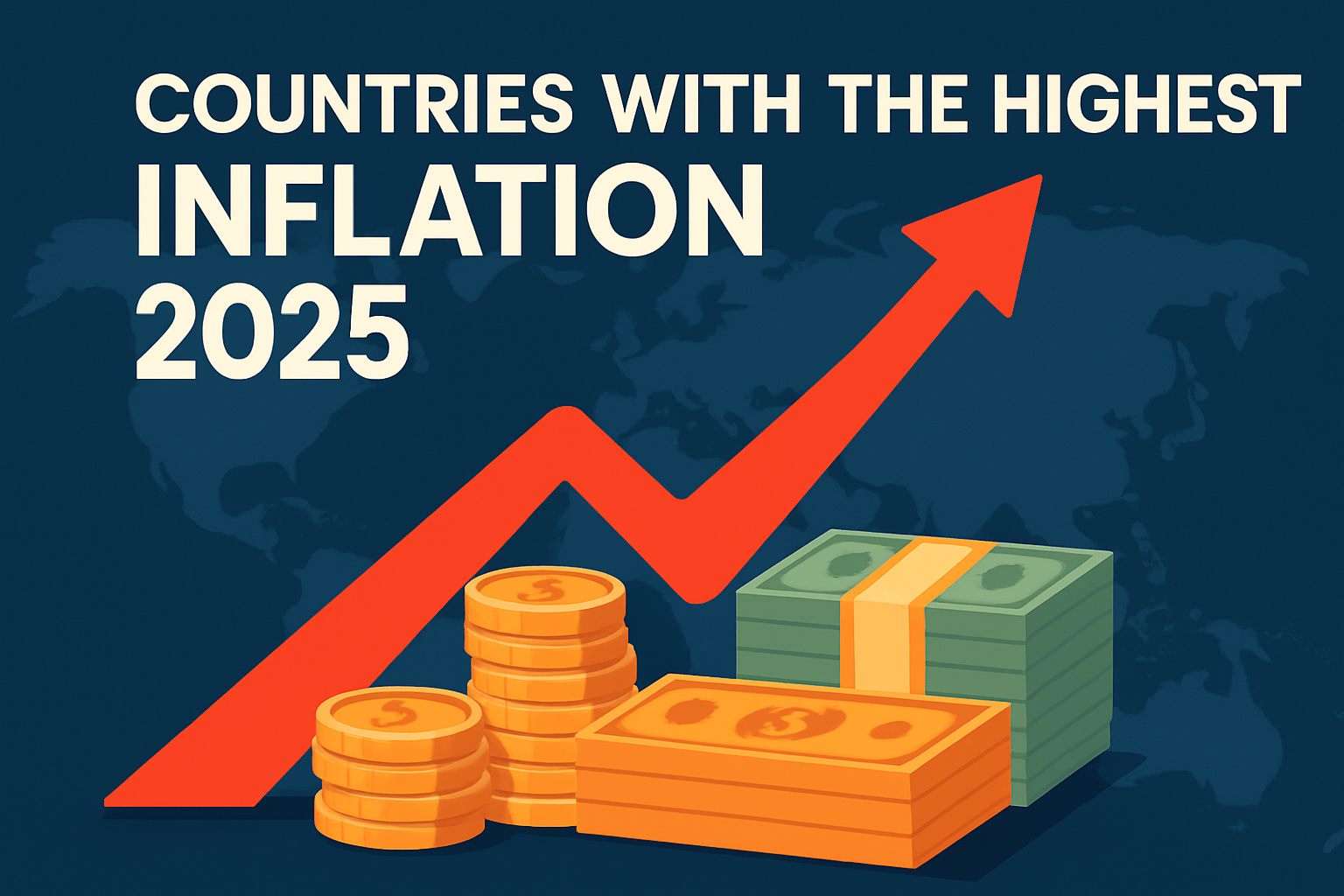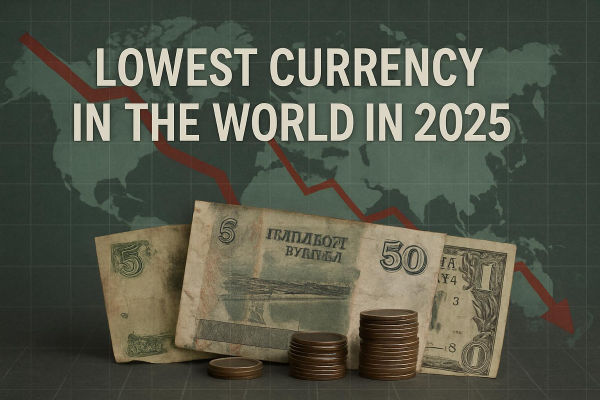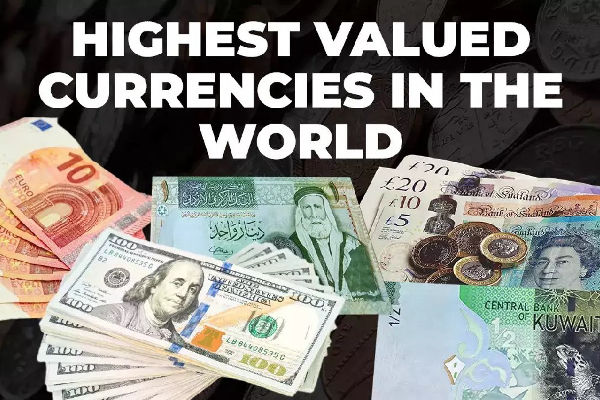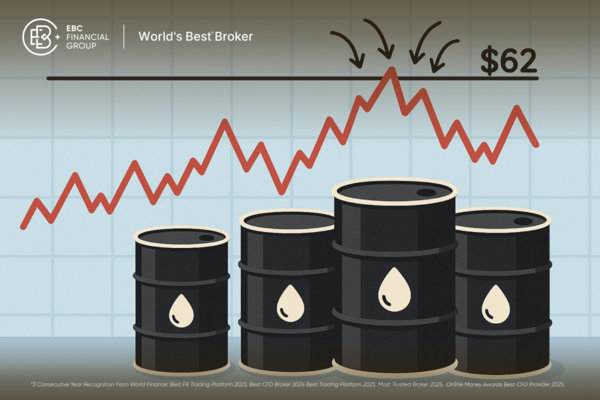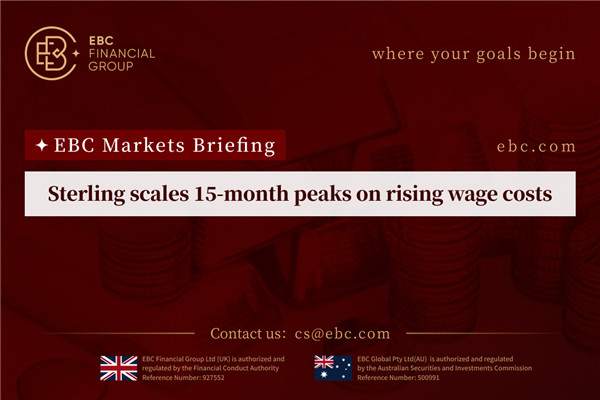While many major economies are seeing success in bringing inflation back down to target levels (typically around 2%), a critical group of developing nations and conflict zones is grappling with severe, and in some cases triple-digit, price growth.
This cost of living crisis is not merely an economic concern; it is a pressing humanitarian issue, eroding purchasing power and threatening the stability of some of the world's most vulnerable states.
This report breaks down the latest projected annual average inflation rates for 2025 and details the critical causes behind these extreme price movements.
Top 15 Countries by Inflation (2025)
Here is a detailed breakdown of the 15 countries with the highest projected inflation rates for 2025.
Note: The figures represent the projected annual average inflation rate for the full year 2025.
| Rank |
Country |
Projected 2025 Inflation |
2024 GDP |
GDP (Real Growth, Annual %) |
| 1 |
Venezuela |
269.9% |
$82.77 Billion |
0.5% |
| 2 |
South Sudan |
97.5% |
$4.65 Billion |
5.3% |
| 3 |
Zimbabwe |
89.0% |
$44.19 Billion |
2.0% |
| 4 |
Sudan |
87.2% |
$49.91 Billion |
-13.5% |
| 5 |
Iran |
42.4% |
$436.90 Billion |
3.0% |
| 6 |
Argentina |
41.3% |
$633.3 Billion |
2.0% |
| 7 |
Burundi |
37.3% |
$2.162 Billion |
3.5% |
| 8 |
Turkey |
34.9% |
$1.323 trillion |
3.2% |
| 9 |
Myanmar |
31.0% |
$74.08Billion |
-1.0% |
| 10 |
Malawi |
28.2% |
$11.01 Billion |
1.8% |
| 11 |
Haiti |
27.8% |
$25.22 Billion |
-4.2% |
| 12 |
Nigeria |
23.0% |
$187.80 Billion |
3.4% |
| 13 |
Angola |
21.6% |
$80.4Billion |
4.4% |
| 14 |
Bolivia |
20.8% |
$49.67Billion |
1.4% |
| 15 |
Egypt |
20.4% |
$389.1 Billion |
2.4% |
1. Venezuela (269.9%)
Venezuela's inflation stems from a long-term economic crisis, the collapse of its state-owned oil company (PDVSA), and crippling international sanctions.
The government has resorted to hyper-monetizing its debt by printing money to cover massive deficits, which has destroyed all confidence in the currency.
This has resulted in a total loss of faith in the bolívar, which is effectively worthless. The economy is now unofficially dollarized, as citizens use the USD or hard assets like gold to preserve any remaining wealth.
| Metric |
Venezuela (VES) |
| Current Gold Price |
1 Oz = 9.36 million VES |
| Currency Rate (May,2025) |
1 USD = 92.70 VES |
| Current Price |
1 USD = 230.76 VES |
The situation remains uncontrolled, though the 2025 projection is slower than the multi-million-percent hyperinflation seen in past years. Without deep structural reform and the lifting of sanctions, the bolívar will continue to depreciate and sadly, inflation will remain in the triple digits.
2. South Sudan (97.5%)
Inflation is driven by a near-total dependence on oil revenue, its only significant source of income. This crisis was triggered by the civil war in neighboring Sudan, which damaged the only export pipeline, cutting off government funds.
The fiscal implosion forced the government to print money, causing the South Sudanese pound (SSP) to collapse. With no hard currency inflows, the exchange rate for essential imported food and medicine has skyrocketed.
| Metric |
South Sudan (SSP) |
| Current Gold Price |
1 Oz = 528,477 SSP |
| Currency Rate (Oct,2024) |
1 USD = 98.00 SSP |
| Current Price |
1 USD = 130.26 SSP |
This inflation is uncontrolled and is not an economic problem at its core; it is a geopolitical and security crisis. Until the pipeline is repaired and peace is stable, the currency will continue to fall, and inflation will accelerate.
3. Zimbabwe (89.0%)
The inflation of Zimbabwe shows persistent currency instability.
While the introduction of the new "ZiG" currency in April 2024 has provided some relief to slow monthly inflation, the annual rate remains high due to the carry-over effects of hyperinflation from the previous currency and a deep lack of public confidence.
| Metric |
Zimbabwe (ZiG) |
| Current Gold Price |
1 Oz = 108,131 ZiG |
| Currency Rate (Apr,2024) |
1 USD = 13.56 ZiG |
| Current Price |
1 USD = 26.66 ZiG |
The situation is fragile as the government attempts to build trust in the new currency. While the monthly rate has slowed, the outlook depends entirely on the central bank's discipline and ability to maintain the ZiG's backing without resorting to printing money.
4. Sudan (87.2%)
The key driver here is the devastating civil war that began in 2023. This has precipitated a full-blown currency crisis, with the Sudanese pound (SDG) experiencing a near-total collapse.
The resulting import paralysis has created acute shortages of essential goods, forcing economic actors to flee to hard assets, primarily gold, as the only viable store of value. Hard assets like gold are the only remaining store of value as the currency is worthless.
| Metric |
Sudan (SDG) |
| Current Gold Price |
1 Oz = 10.86 Million SDG |
| Currency Rate (2023) |
1 USD = 598.00 SDG |
| Current Price |
1 USD = 2,679.00 SDG |
This situation in Sudan is entirely uncontrolled and represents a complete humanitarian and economic catastrophe. There is no monetary solution; inflation will continue to accelerate as long as the conflict rages.
5. Iran (42.4%)
Iran's chronic inflation, at 42.4%, is driven by persistent international sanctions that restrict oil exports and access to global finance. High government spending is then financed by the central bank, steadily devaluing the currency.
The Iranian rial (IRR) has steadily depreciated on the black market, making imports extremely expensive. This fuels domestic price hikes as the purchasing power of the rial evaporates.
| Metric |
Iran (IRR) |
| Current Gold Price |
1 Oz = 1.95 Billion IRR |
| Currency Rate (2024) |
1 USD = 385,000 IRR |
| Current Price |
1 USD = 480,000 IRR |
This inflation is uncontrolled by conventional monetary policy, as it is structurally tied to geopolitical tensions. Without sanctions relief, the government will continue to monetize its deficit, and high inflation will persist.
6. Argentina (41.3%)
This high annual rate is a vast improvement from 2024 but remains severe, driven by the ongoing, painful effects of President Milei's "shock" austerity program, a large initial currency devaluation, and the removal of subsidies, which, while reducing monthly inflation, keep annual averages high.
The official peso-to-dollar conversion rate was massively adjusted, front-loading the economic pain. While this caused an initial price surge, the government's hard stop on printing money has caused the parallel ("blue") exchange rate to stabilize.
| Metric |
Argentina (ARS) |
| Current Gold Price |
1 Oz = 5.90 Million ARS |
| Currency Rate (2023) |
1 USD = 350.00 ARS |
| Current Price |
1 USD = 1,452.73 ARS |
This is a controlled, albeit painful, disinflation. By achieving a fiscal surplus, the government has anchored the currency, and monthly inflation is slowing dramatically, with projections for a significant drop in 2026 if the political will for austerity holds.
7. Burundi (37.3%)
Burundi's inflation is driven by a stagnant economy, high dependency on foreign aid, and severe price shocks to imported food and fuel. The country lacks the foreign currency reserves to buffer these external shocks.
The Burundian franc (BIF) is under intense pressure, with a wide gap between the official and black market exchange rates. This makes essential imports prohibitively expensive for the population.
| Metric |
Burundi (BIF) |
| Current Gold Price |
1 Oz = 11.92 Million BIF |
| Currency Rate (2024) |
1 USD = 2,800.00 BIF |
| Current Price |
1 USD = 2,936.79 BIF |
The situation is uncontrolled, as the central bank lacks the monetary tools or foreign reserves to intervene effectively. The outlook is poor and highly dependent on foreign aid or a drop in global commodity prices.
8. Turkey (Türkiye) (34.9%)
Turkey's 34.9% inflation is the direct legacy of its past unorthodox monetary policy, where cutting rates despite high inflation triggered a severe currency crisis.
This policy caused a catastrophic depreciation, sending the USD/TRY exchange rate to historic highs and destroying public confidence in the lira.
Since 2023, the central bank has executed a dramatic pivot to orthodoxy, aggressively hiking rates to stabilize the currency. While this has slowed the lira's slide, the damage from the massively depreciated USD/TRY exchange rate is already priced in, locking in an entrenched, high cost of living.
| Metric |
Turkey (TRY) |
| Current Gold Price |
1 Oz = 171,280 TRY |
| Currency Rate (Jan,2024) |
1 USD = 28.50 TRY |
| Current Price |
1 USD = 42.23 TRY |
This inflation is now being actively and aggressively controlled. The outlook is one of "painful improvement," and projections show inflation falling significantly in 2026, provided the central bank maintains its independence.
9. Myanmar (31.0%)
This is caused by the widespread civil conflict and political instability that have destroyed production and supply chains. The chaos has destroyed production, shattered supply chains, and forced the central bank to print money to finance the military regime.
This dual crisis has triggered a collapse of the national currency, the kyat (MMK). The currency's freefall has, in turn, created a critical shortage of U.S. dollars, crippling the country's ability to pay for essential imports and causing prices for basic necessities to surge.
| Metric |
Myanmar (MMK) |
| Current Gold Price |
1 Oz = 16.22 Million MMK |
| Currency Rate (2021) |
1 USD = 2,200.00 MMK |
| Current Price |
1 USD = 4,000.00 MMK |
The inflationary environment is entirely unanchored and driven by political, not monetary, factors. Conventional economic solutions are non-existent in this context, and the outlook remains negative, with any hope of stabilization contingent on a resolution to the ongoing conflict.
10. Malawi (28.2%)
Malawi’s inflation is caused by severe foreign currency shortage, a high public debt burden, and the lingering effects of a massive currency devaluation in 2024. This was compounded by El Niño-induced droughts that crippled agricultural output, driving up food prices.
This devaluation, while necessary, led to an immediate and severe passthrough effect, making essential imports like fuel and fertilizer prohibitively expensive. The high public debt burden gives the government little room to maneuver.
| Metric |
Malawi (MWK) |
| Current Gold Price |
1 Oz = 7.03 Million MWK |
| Currency Rate (2023) |
1 USD = 1,020.00 MWK |
| Current Price |
1 USD = 1,733.67 MWK |
The economy is now being managed under this painful, IMF-backed program, which mandates tight monetary policy to re-anchor inflation expectations. This recovery remains exceptionally vulnerable to external shocks, particularly climate events and global commodity prices.
11. Haiti (27.8%)
Haiti's inflation is not a monetary issue but a symptom of a failed state and total institutional collapse. Escalating gang violence has blockaded main ports and transport routes, halting the flow of goods.
With no domestic production and no imports, the country is facing severe shortages of all basic necessities, causing prices to skyrocket. The Haitian gourde (HTG) is worthless, and the U.S. dollar is the only trusted medium of exchange.
| Metric |
Haiti (HTG) |
| Current Gold Price |
1 Oz = 531,090 HTG |
| Currency Rate (Early 2025) |
1 USD = 131.00 HTG |
| Current Price |
1 USD = 131.00 HTG |
The situation is anarchic and uncontrolled. No central bank or government entity is capable of managing the economy, and stabilization is impossible until basic security is restored.
12. Nigeria (23.0%)
Nigeria’s inflation is caused by the inflationary effects of major economic reforms in 2024, specifically the removal of the popular fuel subsidy and the devaluation and floating of the national currency, the naira.
The naira (NGN) depreciated massively, drastically increasing the price of all imported goods, while the subsidy removal caused transport and energy costs to triple. The central bank is now aggressively raising interest rates to combat this.
| Metric |
Nigeria (NGN) |
| Current Gold Price |
1 Oz = 5.93 Million NGN |
| Currency Rate (2024) |
1 USD = 850.00 NGN |
| Current Price |
1 USD = 1,462.16 NGN |
This is a policy-induced inflation that is now being actively controlled. The outlook is for a gradual decline in inflation through 2026, but the short-term impact on the population has been severe.
13. Angola (21.6%)
Angola's inflation is driven by the government's reduction of fuel subsidies and a large depreciation of its currency, the kwanza (AOA). The economy is also strained by high-interest payments on its sovereign debt.
As a major oil exporter, the economy is highly dependent on oil prices to service its USD-denominated debt. The currency's weakness makes all imports more expensive, fueling inflation.
| Metric |
Angola (AOA) |
| Current Gold Price |
1 Oz = 3.70 Million AOA |
| Currency Rate (Jan,2024) |
1 USD = 750.00 AOA |
| Current Price |
1 USD = 911.97 AOA |
The situation is under fragile control, as the central bank tightens monetary policy. The outlook depends on continued fiscal discipline and stable oil prices to ease pressure on the kwanza.
14. Bolivia (20.8%)
The inflation in Bolivia is a new and severe crisis, caused by a collapse in its natural gas exports. This has led to a critical shortage of U.S. dollars, depleting the central bank's foreign reserves.
The long-standing currency peg of the boliviano (BOB) is no longer tenable, and a thriving black market for U.S. dollars has emerged at a much higher rate. This "parallel" exchange rate is driving up the price of all imported goods.
| Metric |
Bolivia (BOB) |
| Current Gold Price |
1 Oz = 34,475 BOB |
| Currency Rate (2023) |
1 USD = 6.86 BOB |
| Current Price |
1 USD = 8.50 BOB |
The situation is not well-controlled, as the government has so far resisted a necessary official devaluation. Inflationary pressures will continue to build until the currency's official value is realigned with its market value.
15. Egypt (20.4%)
Egypt's inflation is a direct and anticipated consequence of a major policy shift in March 2025. This involved a managed, massive devaluation of the Egyptian pound (EGP) as a key requirement to unlock a new, expanded IMF loan agreement.
This move was deemed necessary to resolve a severe foreign currency shortage that had previously crippled the economy.
The Egyptian pound (EGP) was allowed to float freely, making all imports, especially essential food and fuel, instantly more expensive. In response, the central bank aggressively hiked interest rates to anchor inflation expectations.
| Metric |
Egypt (EGP) |
| Current Gold Price |
1 Oz = 191,372 EGP |
| Currency Rate (2024) |
1 USD = 30.80 EGP |
| Current Price |
1 USD = 47.17 EGP |
This is a controlled economic "shock." Monthly inflation has already begun to slow, and with the new financing unlocked, the outlook is positive for a significant drop in inflation in 2CSS 2026.
Future Outlook for These Countries (2026 Projections)

The collective 2026 outlook for these nations is one of sharp divergence, with any improvement heavily dependent on policy discipline and political stability.
While a general global trend of disinflation is expected, the paths for these specific countries are split. Nations undergoing painful but orthodox policy reforms, such as Argentina, Turkey, and Egypt, are projected to see significant improvement.
Argentina's inflation is forecast to slow to the mid-teens (around 16.5%), while Turkey's central bank is targeting 16%, and Egypt aims for 10.5%. Zimbabwe also anticipates a major slowdown to around 12.5% as its new currency gains traction.
Conversely, countries mired in active conflict or facing severe sanctions show a grim forecast. For Sudan, South Sudan, Haiti, and Myanmar, no economic recovery is expected in 2026 without a resolution to violence and a reopening of trade routes.
Similarly, Iran's inflation is projected to remain stuck at dangerously high levels, around 40%, as sanctions and regional instability continue to cripple its economy.
For chronic hyperinflation victims like Venezuela, inflation is projected to ease but will remain in the triple digits, forecast at over 200% for 2026.
Frequently Asked Questions (FAQ)
1. Which country has the highest inflation right now?
Venezuela is projected to have the highest annual average inflation in 2025 at 269.9%, maintaining a multi-year lead due to hyperinflation.
2. What is considered a bad inflation rate?
An inflation rate consistently above 10% is considered severe, as it causes economic harm and political instability. Rates above 50% per month are defined as hyperinflation.
3. What is the difference between CPI and inflation?
The Consumer Price Index (CPI) is the measure of the average change in prices paid by urban consumers for a basket of goods and services. Inflation is the rate of change of the CPI over time (e.g., year-over-year).
Conclusion
In conclusion, the 2025 data on the Top 15 Countries with the Highest Inflation reveals a critical divide in the global economy, driven predominantly by conflict, political instability, and severe currency mismanagement.
The extreme price volatility, particularly in triple-digit nations like Venezuela and Sudan, is not just an economic indicator but a direct measure of humanitarian crisis and eroding social stability.
While some countries are on a slow path to stabilization through painful reforms, the sustained economic recovery for the most affected nations hinges entirely on achieving political peace and maintaining credible, long-term monetary discipline.
Disclaimer: This material is strictly for general informational purposes and is not intended as, nor should it be considered, financial or investment advice. The country rankings and projected inflation figures are compiled from various primary sources, including the International Monetary Fund (IMF). While efforts are made for careful compilation, the author and publisher assume no liability for the accuracy or completeness of data derived from these external sources. No opinion expressed herein constitutes a recommendation that any particular investment strategy is suitable for any specific person.
